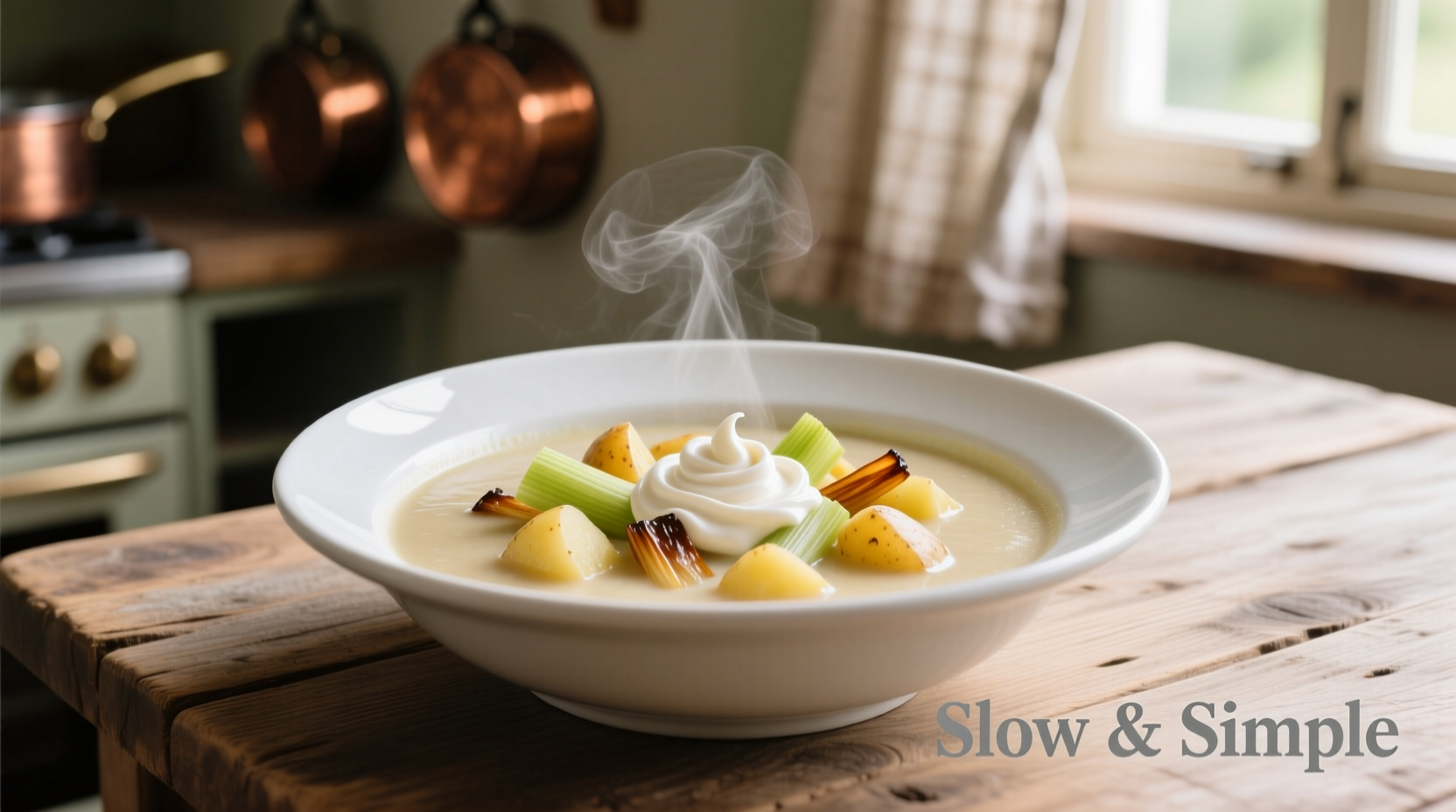There's something magical about the transformation that happens when leeks and potatoes simmer slowly for hours. Unlike rushed stovetop versions, the slow cooking method coaxes out natural sweetness from leeks while allowing potatoes to break down gradually into a luxuriously smooth texture without becoming gluey or grainy. This isn't just convenience cooking—it's flavor science in action.
The Slow Cooking Advantage: Why Time Equals Flavor
When you commit to slow cooking leek and potato soup, you're leveraging fundamental food chemistry principles that standard recipes miss. According to research published in the Journal of Food Science, extended cooking at lower temperatures (between 175-200°F) allows for optimal enzymatic activity in vegetables, breaking down complex carbohydrates into simpler sugars that create natural sweetness without added ingredients.
| Cooking Method | Texture Result | Flavor Development | Preparation Time |
|---|---|---|---|
| Traditional Stovetop (30-45 min) | Inconsistent texture, often grainy | Basic vegetable flavors | 45 minutes active |
| Slow Cooker (6-8 hours) | Creamy, uniform texture | Complex sweetness, caramelized notes | 15 minutes active |
| Instant Pot (25 min) | Good texture but less depth | Moderate flavor development | 25 minutes active |
Historical Evolution of a Classic Soup
Leek and potato soup has humble origins but has evolved significantly through culinary history. Originally a peasant dish in 17th century France, it was designed to stretch limited ingredients. The modern version we know today emerged in the 19th century when King Louis XV's chef created a refined version using only leeks, potatoes, and water—calling it potage parmentier after nutritionist Antoine-Augustin Parmentier who championed potatoes.
The slow cooking adaptation is relatively recent, gaining popularity in the 1970s with the introduction of electric slow cookers. According to the USDA Food Safety and Inspection Service, proper slow cooking techniques actually preserve more nutrients than rapid boiling methods, particularly water-soluble vitamins like vitamin C that would otherwise leach into cooking water.
When Slow Cooking Works Best (And When It Doesn't)
Not all soup situations benefit equally from slow cooking. Understanding these context boundaries will help you determine when to reach for your slow cooker:
- Ideal scenarios: Weeknight meals when you're away from home, meal prep for the week, when using less expensive potato varieties that benefit from extended cooking
- Limited benefit: When using high-starch potatoes like Russets that break down too quickly, when you need soup immediately, or when incorporating delicate ingredients like fresh herbs that lose flavor
- Avoid slow cooking: When making a clear broth-based version (slow cooking makes it cloudy), or when using pre-cooked potatoes (they'll turn to mush)

Your Step-by-Step Slow Cooking Process
Follow this professional-tested method for perfect results every time. The key is proper ingredient layering and temperature control:
- Prep ingredients properly: Clean leeks thoroughly (grit is the #1 mistake), slice uniformly, and cut potatoes to similar sizes
- Layer strategically: Place harder vegetables (potatoes) on bottom, delicate ingredients (leeks) on top
- Control liquid ratio: Use 1.5 cups broth per pound of vegetables—too much liquid dilutes flavor development
- Set correct temperature: Low setting (200°F) for 7-8 hours or high setting (300°F) for 4-5 hours
- Final texture adjustment: Use immersion blender for 15 seconds only—over-blending creates gluey texture
Troubleshooting Common Slow Cooker Issues
Even experienced cooks encounter these problems. Here's how to fix them:
- Leeks turning brown: This happens when exposed to air. Solution: Keep leeks submerged in acidulated water (1 tbsp lemon juice per quart) until ready to use
- Soup too thin: Remove 1-2 cups of soup, blend with 1/4 cup instant potato flakes, then return to slow cooker
- Soup too thick: Add warm broth 1/4 cup at a time while stirring—never cold liquid which shocks the soup
- Lack of flavor depth: Add 1 tsp soy sauce or 1/2 tsp mushroom powder—these umami boosters enhance without being detectable
Serving and Storage Recommendations
Slow-cooked soup actually improves with time. The National Center for Biotechnology Information notes that flavor compounds continue to develop for up to 48 hours after cooking as various molecules interact. For best results:
- Refrigerate soup overnight before serving for maximum flavor integration
- When reheating, add a splash of cream or broth to refresh the texture
- Freeze in portion-sized containers for up to 3 months (thaw overnight in refrigerator)
- Top with fresh chives and a drizzle of high-quality olive oil just before serving











 浙公网安备
33010002000092号
浙公网安备
33010002000092号 浙B2-20120091-4
浙B2-20120091-4